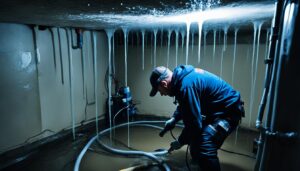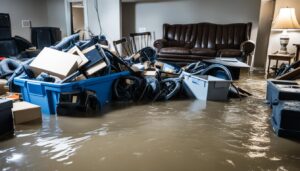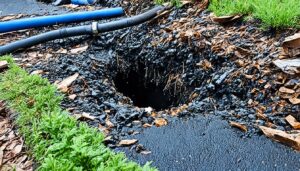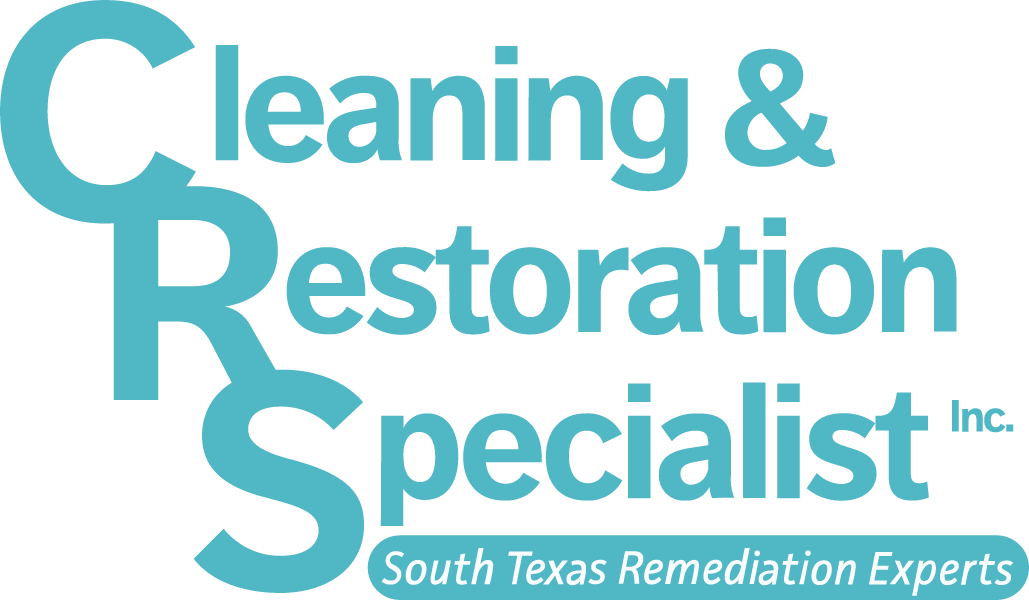Imagine coming home after a long day, hoping to unwind and relax in the comfort of your own space. But as you open the door, you are greeted by a sight that makes your heart sink. The unmistakable stench of sewage fills the air, and you realize with a sinking feeling that your home has been affected by a sewage backup.
It’s a situation that no one wants to find themselves in, yet it happens more often than we’d like to think. Dealing with a sewage backup is not just a matter of inconvenience; it raises serious safety concerns that cannot be ignored. The aftermath of a sewage backup can pose potential health risks and jeopardize the well-being of you and your loved ones.
But before you panic, it’s crucial to understand the extent of the risks involved and what steps you can take to ensure your safety. This article will delve into the potential hazards that come with living in a house after a sewage backup and provide valuable insights on how to protect yourself and your home.
So, if you’ve ever wondered about the safety of inhabiting a house after a sewage backup, read on. Knowledge is power when it comes to safeguarding your health and creating a secure living environment for you and your family.
Understanding Sewage Backup Risks
When it comes to sewage backups, it is essential to understand the potential causes and risks involved. Sewage backups can occur for various reasons, including:
- Blocked sewer lines: Accumulation of debris, tree roots, or grease can obstruct the sewer lines, leading to backups.
- Heavy rainfall: Excessive rainwater entering the sewer system can overwhelm the pipes, causing sewage backups.
- Tree root infiltration: Tree roots seeking moisture can penetrate sewer pipes, causing blockages and backups.
- Damage to septic systems: A malfunctioning or damaged septic system can result in sewage backups.
- Improper waste disposal: Flushing non-biodegradable items or pouring grease down the drain can clog the sewer pipes, leading to backups.
Understanding these potential causes of sewage backups is crucial for implementing preventive measures and minimizing the risk of future incidents. By addressing the underlying issues and taking appropriate actions, homeowners can protect their properties and maintain a healthy living environment.
Health Hazards Associated with Sewage Exposure
Exposure to sewage can pose significant health risks and lead to the transmission of various diseases. It is crucial to be aware of the potential hazards and take necessary precautions to protect your health and well-being.
When sewage backup occurs, it can contaminate the environment with harmful bacteria, viruses, parasites, and other pathogens. Direct contact with sewage or inhalation of contaminated air can result in bacterial infections such as gastroenteritis, urinary tract infections, and skin infections.
Viral infections, such as hepatitis A and norovirus, can also be transmitted through sewage exposure. These viruses can cause severe gastrointestinal symptoms and pose a particular risk to individuals with weakened immune systems.
In addition to bacterial and viral infections, sewage exposure can lead to parasitic diseases. Parasites such as Cryptosporidium and Giardia can be present in sewage and cause gastrointestinal illness, including diarrhea and abdominal cramps.
Furthermore, exposure to sewage can contribute to respiratory issues. The release of toxins and irritants from sewage can exacerbate existing respiratory conditions or lead to the development of new respiratory problems.
To protect yourself from the health risks associated with sewage exposure, it is essential to follow proper safety measures. Use personal protective equipment such as gloves, masks, and protective clothing when handling sewage or cleaning up after a sewage backup. Thoroughly wash your hands with soap and clean water after any contact with sewage.
It is recommended to seek medical attention if you experience symptoms of illness after exposure to sewage, such as persistent diarrhea, vomiting, fever, or respiratory distress.
By being aware of the health hazards and taking necessary precautions, you can minimize the risks associated with sewage exposure and maintain a safe and healthy environment.
Components of a Safe Cleanup and Restoration Process
Proper cleanup and restoration after a sewage backup are essential to ensure the health and safety of the occupants, as well as to prevent further damage to the property. The process involves several key components and steps to effectively and safely restore the affected area.
1. Initial Assessment:
The first step in the cleanup and restoration process is to assess the extent of the damage caused by the sewage backup. This includes identifying the affected areas, determining the extent of contamination, and evaluating any structural or electrical damage that may have occurred.
2. Safety Precautions:
Prior to starting the cleanup process, it is crucial to take appropriate safety precautions. This includes wearing personal protective equipment (PPE), such as gloves, masks, and protective clothing, to avoid direct contact with sewage and minimize the risk of contamination.
3. Containment:
Containing the affected area is crucial to prevent further spread of sewage and cross-contamination. This involves isolating the contaminated area with physical barriers and implementing proper ventilation to minimize odors and airborne contaminants.
4. Removal of Contaminated Materials:
The next step is to remove and dispose of all contaminated materials in a safe and appropriate manner. This includes carpets, furniture, drywall, insulation, and any other items that have been affected by the sewage backup. Proper disposal methods should be followed to prevent further contamination.
5. Thorough Cleaning and Disinfection:
After the removal of contaminated materials, the affected area should be thoroughly cleaned and disinfected. Specialized disinfectants should be used to kill bacteria, viruses, and other pathogens present in the sewage. All surfaces, including walls, floors, and fixtures, should be cleaned and disinfected following industry standards.
6. Drying and Dehumidification:
Once the area is cleaned and disinfected, it is important to dry and dehumidify the space to prevent mold growth. This may require the use of professional-grade drying equipment, such as dehumidifiers and air movers, to ensure thorough drying and prevent moisture-related issues.
7. Restoration and Repairs:
After the area is clean and dry, restoration and repairs can begin. This may involve replacing damaged materials, repairing structural damage, and restoring the affected area to its pre-damage condition. Professional contractors may be needed to perform these tasks and ensure the quality of the restoration work.
By following these essential components and steps of a safe cleanup and restoration process, the health risks associated with sewage backup can be minimized, and the affected area can be effectively restored to a safe and livable condition.
Structural and Environmental Concerns Post-Backup
Sewage backups can have a significant impact on both the structural integrity of a house and the environment. The aftermath of a sewage backup can result in various concerns that need to be addressed promptly to ensure the safety and well-being of the occupants.
One of the primary concerns following a sewage backup is the potential structural damage it can cause. Sewage contains corrosive substances and high levels of moisture, which can weaken the building materials over time. This can lead to issues such as rotting wood, corrosion of metal structures, and even compromised foundations. Immediate action is necessary to assess and repair any structural damage caused by the backup to prevent further deterioration and ensure the stability of the house.
Additionally, the environmental impact of a sewage backup should not be overlooked. Sewage is a hazardous substance that can contaminate soil, groundwater, and bodies of water if not properly managed. It contains harmful bacteria, viruses, and other pathogens that can pose health risks to humans, animals, and the overall ecosystem. Environmental remediation measures should be taken to mitigate the spread of contamination and restore the affected area to its pre-backup condition.
How Long Should You Wait Before Reentering Your Home?
After a sewage backup, it is crucial to wait for the appropriate time before reentering your home. This ensures the safety of you and your family. Reentering too soon can expose you to potential health hazards and increase the risk of contamination. The timeline for returning home after a sewage backup depends on several factors, including the severity of the backup, the extent of the damage, and the effectiveness of the cleanup and restoration process.
It is recommended to consult with a professional restoration company or a qualified plumber to assess the situation and determine when it is safe to reenter your home. They have the expertise to evaluate the level of contamination and the effectiveness of the cleanup efforts. Depending on the specific circumstances, they may recommend additional testing or treatment before deeming your home safe for occupancy.
In general, it is essential to allow sufficient time for the affected area to dry thoroughly and for any lingering odors to dissipate. This helps ensure that the environment is free from harmful bacteria, fungi, or other contaminants that can cause health problems. The restoration process may involve proper disinfection, removal of damaged materials, and thorough cleaning of all surfaces. Following these steps diligently will contribute to a safe and healthy living space.
It’s crucial to prioritize your safety and the safety of your loved ones when considering reentering your home after a sewage backup. While it may be tempting to rush back in, taking the necessary precautions and waiting until the proper cleanup and restoration measures have been completed is essential for your well-being.
Preventative Measures to Avoid Future Sewage Backups
Taking proactive measures is essential in preventing future sewage backups and protecting your home from potential risks. By following these valuable tips and strategies, you can minimize the chances of sewage backups occurring.
- Maintain regular sewer line inspections: Schedule routine inspections to identify any potential issues or blockages in your sewer lines. This proactive approach can help prevent backups caused by clogs or structural defects.
- Properly dispose of waste: Avoid flushing items that can clog your sewer system, such as feminine hygiene products, diapers, paper towels, or grease. Dispose of these items in the appropriate waste receptacles.
- Be mindful of landscaping: Plant trees and shrubs a safe distance away from your sewer lines to prevent root infiltration, which can cause blockages and backups. Consult with a professional if you suspect any tree roots are intruding on your sewer lines.
- Install a backwater valve: Consider installing a backwater valve, which can help prevent sewage from flowing back into your home during heavy rainfall or sewer line backups.
- Keep gutters and downspouts clear: Regularly clean and maintain your gutters and downspouts to prevent excess water from overflowing and seeping into your sewer system.
- Monitor water usage: Be mindful of excessive water usage, as it can put added strain on your sewer system. Fix any leaks promptly and practice water conservation to reduce the risk of backups.
- Educate household members: Teach everyone in your household about the importance of proper waste disposal and the consequences of flushing inappropriate items down the toilet or drains.
By implementing these preventative measures, you can safeguard your home against sewage backups and enjoy peace of mind knowing that you have taken steps to protect your property and the well-being of your household.
Is it safe to live in a house after sewage backup?
After a sewage backup incident, one of the primary concerns is the safety of inhabiting the affected house. The potential health risks and living conditions after sewage backup require careful consideration to ensure the well-being of the occupants. Proper cleanup and remediation are vital in restoring a safe living environment.
Sewage backups can introduce harmful bacteria, viruses, and other pathogens into the living space. These contaminants can pose serious health hazards if not appropriately addressed. Inhaling or coming into contact with sewage-contaminated materials can lead to various illnesses and infections.
To mitigate the risks associated with post-sewage backup living conditions, thorough cleanup and disinfection are crucial. All affected areas, including surfaces, flooring, and furniture, should be properly cleaned and sanitized using appropriate disinfectants. This helps to eliminate harmful pathogens and reduce the chances of contamination.
In addition to cleaning, it is essential to address any structural damage caused by the sewage backup. Structural integrity issues can lead to further health and safety concerns. Professionals should assess the damage and provide the necessary repairs and renovations to ensure the house is safe for occupancy.
Regular monitoring of the property and plumbing systems is recommended to identify potential issues that could lead to future sewage backups. Taking proactive measures such as proper waste disposal, regular maintenance of sewer lines, and installing backflow preventers can help prevent similar incidents from occurring.
When it comes to the safety of inhabiting a house after a sewage backup, it is crucial to prioritize the health and well-being of the occupants. By following proper cleanup and restoration procedures, addressing any lingering risks, and implementing preventative measures, residents can create a safe living environment even after a sewage backup.
Conclusion
In conclusion, living in a house after a sewage backup can pose potential health risks and safety concerns. It is crucial for residents to understand and address these hazards to ensure a safe living environment.
Exposure to sewage can lead to various health hazards, including bacterial and viral infections, parasitic diseases, and respiratory issues. Therefore, it is important to take necessary precautions to protect oneself and other occupants.
Proper cleanup and restoration after a sewage backup are essential to minimize health risks and prevent further damage. By following the recommended sanitation procedures and ensuring a thorough cleanup, residents can mitigate potential dangers and restore their house to a safe condition.
Taking proactive measures to prevent future sewage backups is equally important. By implementing preventative strategies such as regular maintenance of sewer lines, proper waste disposal, and moisture control, homeowners can decrease the likelihood of facing another sewage backup.
By staying informed about the risks associated with living in a house after a sewage backup and adopting necessary safety measures, residents can create a safe and healthy living environment for themselves and their families. Remember, a thorough understanding of the hazards, proper sanitation procedures, and preventative measures is key to ensuring a safer and more secure living space.
FAQ
Is it safe to live in a house after sewage backup?
Living in a house after a sewage backup can pose potential health risks and safety concerns. It is important to understand the potential hazards and take proper precautions to ensure the safety of the occupants.
What are the causes of sewage backups?
Sewage backups can occur due to various reasons such as blocked sewer lines, heavy rainfall, tree root infiltration, damaged septic systems, or improper waste disposal. Understanding the potential causes of sewage backups can help in preventing future incidents.
What health hazards are associated with sewage exposure?
Exposure to sewage can lead to various health hazards including bacterial infections, viral infections, parasitic diseases, and respiratory issues. It is important to be aware of these risks and take necessary precautions to protect health.
What are the key components of a safe cleanup and restoration process after a sewage backup?
Proper cleanup and restoration after a sewage backup are crucial to minimize health risks and prevent further damage. This section will outline the key components and steps involved in a safe and effective cleanup process.
What are the structural and environmental concerns post-sewage backup?
Sewage backups can cause significant damage to the structural integrity of a house and also pose environmental risks. This section will explore the potential concerns related to structural damage and environmental impact after a sewage backup.
How long should you wait before reentering your home after a sewage backup?
It is important to wait for the appropriate time before reentering a house after a sewage backup to ensure the safety of occupants. This section will provide guidance on the factors to consider and the recommended timeline for reentering a house after a sewage backup.
What are the preventative measures to avoid future sewage backups?
Taking proactive measures can help in preventing future sewage backups. This section will provide valuable tips and strategies to avoid sewage backups and protect your home from potential risks.
Is it safe to live in a house after a sewage backup?
This section will assess the safety of living in a house after a sewage backup, highlighting the importance of proper cleanup and addressing any lingering risks that may affect the occupants’ health and wellbeing.
What are the final thoughts on living in a house after a sewage backup?
In conclusion, living in a house after a sewage backup requires careful consideration of the potential risks and implementation of necessary safety measures. By understanding the hazards associated with sewage exposure and following proper sanitation and restoration procedures, residents can ensure a safe living environment.









